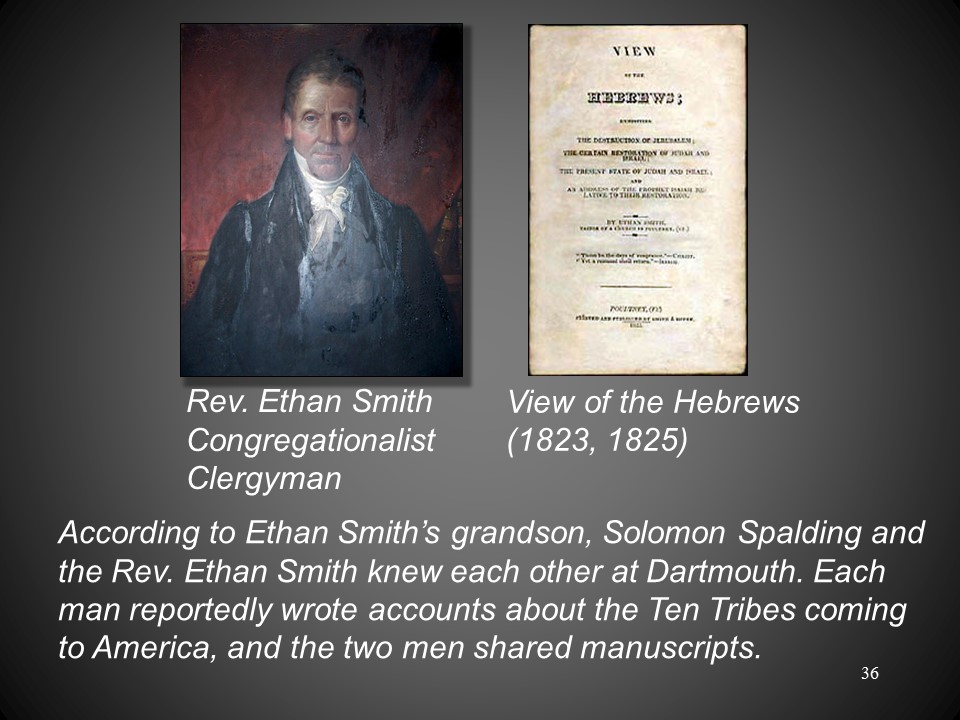Title: Ethan Smith, Rev., (painting).
Other Titles: Rev. Ethan Smith (1762-1849 ?), (painting).
Owner: Boylston Historical Society and Museum, 7 Central Street, P.O. Box 459, Boylston, Massachusetts 01505
Provenance: Formerly in the collection of Boylston Public Library, Main Street, Boylston, Massachusetts 01505 until late 1970s.
Remarks: In the 1970s, the portrait was transferred from the Boylston Public Library to the Boyston Historical Society.
References: Central Massachusetts Biap Survey, 1975.Massachusetts Historical Records Survey, “American Portraits. Found in Massachusetts 1620-1825, Vol.ii” Boston, 1939.Hillenbrand, Richard, 2010.
Spalding’s writing career evidently began not long after his tenure at Dartmouth College. At Dartmouth, Spalding studied under Dr. John Smith, a professor of Biblical Languages and”Natural Philosophy”. Smith advocated several theories regarding Indian origins. Spalding’s time at Dartmouth briefly overlapped that of Ethan Smith – the man who would later become known for his 1823 publication View of the Hebrews, and they apparently knew each other. http://solomonspalding.com/SRP/spld0a.htm. Between 1790 and 1800, both Smith and Spalding reportedly penned accounts about the Ten Tribes coming to America.
See: http://solomonspalding.com/SRP/SRP13p1.htm.
Ethan Smith’s View of the Hebrews contains unique phrases found in The Book of Mormon (“curious workmanship” in 1 Ne 16:10, 1 Ne 18:1, Ether 10:27; “land of liberty” in 2 Ne 1:7, 2 Ne 10:11, Mos 29:32, Alma 46:17; “reckoning of time” – 3 Ne 8:10). See: http://www.lds-mormon.com/voh1.shtml.
Such phrases and thematic parallels have led some to conclude that View of the Hebrews was a source for The Book of Mormon. An alternative explanation is that Ethan Smith and Spalding shared material. There is some evidence for an exchange of manuscripts between Spalding and Ethan Smith is found in the Cleveland Plain Dealer, April 24, 1887.
An anonymous writer reported:
Ethan S. Smith [grandson of Rev. Ethan Smith] recalled that his grandfather wrote a “semi-historical romance” in which “the North American Indians were descended from the lost tribes of Israel, who came over to this continent several hundred years before Christ, built great cities and reached a very high state of civilization.” The story had “as its foundation the migration of the lost tribes of Israel to the western continent,” and “described the hegira from Palestine, the establishment of the Jews in what is now Central America and Mexico, the founding of a great empire and its gradual decline and fall. It told of magnificent cities inhabited by an enlightened and Christian people.” Ethan S. Smith said that his grandfather knew Solomon Spalding, and “granted him a perusal of his unpublished book.” According to the younger Smith, “Spaulding was deeply impressed with the truth of this theory and pursued his investigations even farther than Dr. Smith had ventured”. http://solomonspalding.com/Lib/Smth1887.htm
Salmon S. Osborn claimed to have seen a Spalding manuscript fitting the description of Manuscript Found in Middleton, VT, in 1871:
In September, 1871, I spent some little time in Middleton, Vt., with my wife and her sister, who were both invalids. We had rooms and board at Hezekiah Haynes’. When he learned we were from the vicinity of Kirtland, O., inquiries were made about the Mormons, and I was then told about what they termed the Wood scrape, and that Mormonism undoubtedly originated in that town, and that Mr. Woodard (I think the name was), the Town Clerk, had a “Manuscript” written by Spaulding, which might throw some light on the subject, as he believed Spaulding’s writings and the religious fanaticism of the Woods’ gave rise to Mormonism. From him I learned also, that the Hon. Reuben Wood, late of Cleveland, Ohio, one of the clearest headed lawyers and best of Ohio’s Judges, was a descendant of the same Wood, of Middleton, and himself read law there. I then became interested to know more about it. Soon afterwards I had occasion to call on the Town Clerk, who was also a shoemaker, for a little of his mechanical skill, and procured from him a sight of the manuscript and the rather reluctant loan of it on my promise to use it carefully and return it to him. As I now remember it was written in a fair, plain hand, upon foolscap; short-cap I think, and there may have been one quire or more or less of it stitched together: it purported to be an account of the journeyings of the ten lost tribes of Israel to America, and what they did and became on this continent, by Solomon Spaulding. I had abundance of leisure in Middleton and kept the document a week or more, and returned it to Mr. Woodard. I did not read all of it. It did not interest me much, and I have no distinct recollection of the story, nor had I then the “Book of Mormon”: having lost mine soon after I used it in Chardon, as before stated. I practiced law in Chardon from 1828 to 1833 or ’34 and afterwards in Painesville until 1849.
See: http://www.sidneyrigdon.com/dbroadhu/CA/natruths.htm#010088-1g
